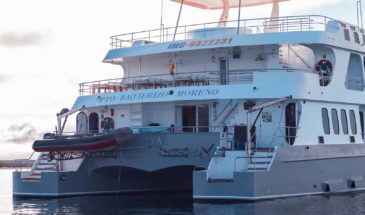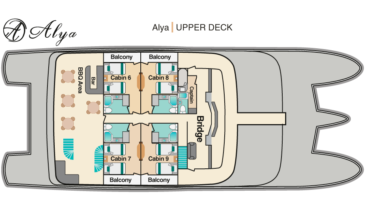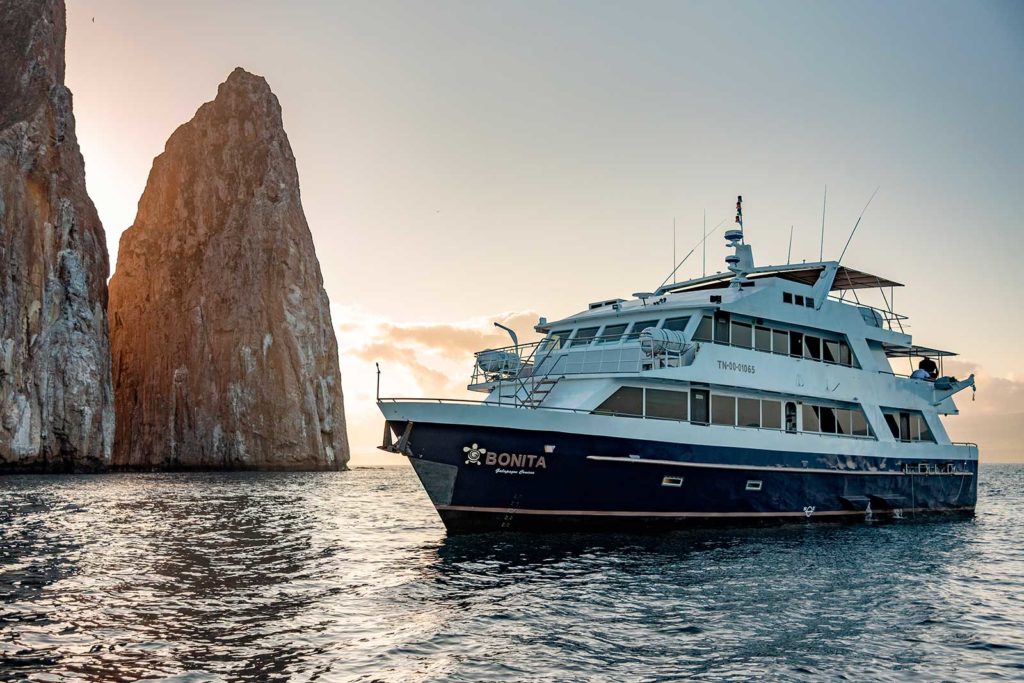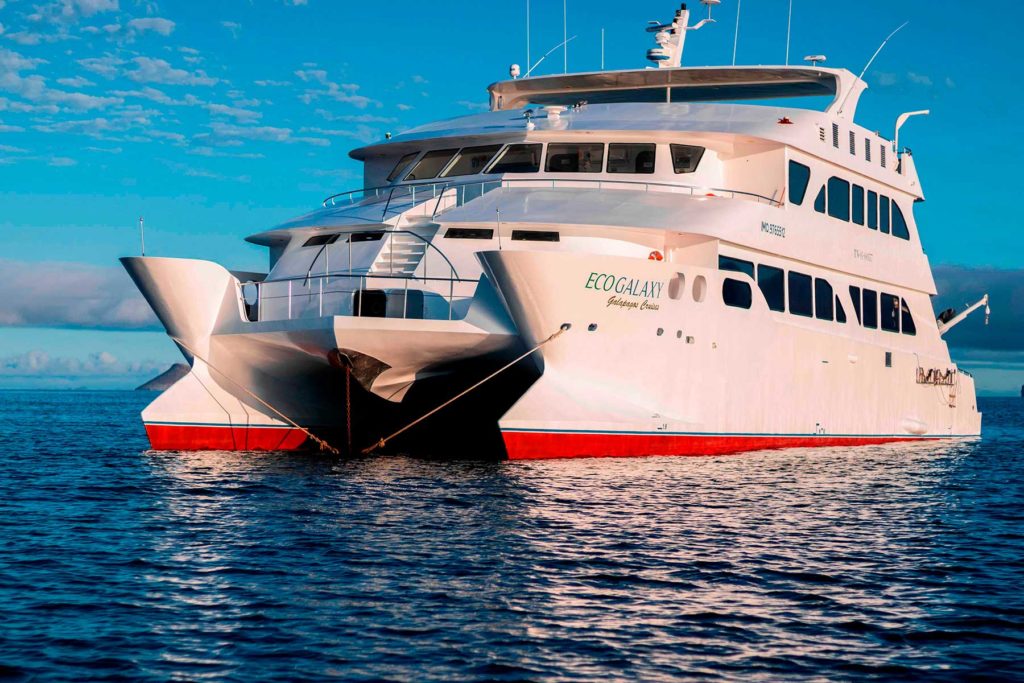- Features
- Rates
- Includes
- Gallery
- Itinerary A - 5 Days
- Itinerary B - 6 Days
- itinerary C - 6 Days
Dimensions
- Length: 31.50 mts / 103.34 ft
- Beam: 12.50 mts / 41.01 ft
- Cruising speed: 12 knots
- Engines: 2 Cumming Motors 350 HP
- 16 passengers
- 9 crew members + 1 bilingual guide
- Electric power: 110V and 220V
- 35 life jackets, 4 lifebuoys 9mm
- Flare gun, smoke signals.
- SOS ‑ashlights signals and other types of visual signals.
- 2 survival rafts, 25 passengers each. Fire extinguishers 10 lb and 2lb.
- Fire hoses 15m. Fire detectors and complete protection system.
- Al fresco dinning area
- Lounge
- Sundeck with hot tub
- Convertible beds
- Panoramic ocean view Windows
- Private balcony
- Spacious closets
- Personalized air conditioning
- Drawer and writing desk
ALYA RATES 2022
PRICE PER PERSON IN DOUBLE CABIN
5 DAYS / 4 NIGHTS CRUISE USD$3.150
6 DAYS / 5 NIGHTS CRUISE USD$3.900
CONDITIONS:
• Single supplement 50%
• Christmas and New Year surcharge 50%
• Discount for children 10%
CONTACT US FOR SPECIAL OFFERS
TRIP INCLUDE
- Airport assistance
- Transfers in Galapagos
- Accommodations in double cabin
- All meals during the cruise
- Naturalist Bilingual Guide
- All visits & excursions according to the itinerary
- Snorkel Gear (mask, tube and fins)
- Kayaks, paddle boards
- Unlimited purified wáter, coffee and tea
- Wetsuit, soft drinks, beach towels
- Local flight to/from Galapagos
- Galapagos National Park Entrance fee
- Galapagos Transit card
- Alcoholic drinks
- Tips
- Local taxes
- Travel insurance
- Service do not specified
ITINERARY A – NORTH
Day 1 - Thursday: Baltra airport – Black Turtle Cove
Day 2 - Friday: Darwin Bay – El Barranco
Day 3 - Saturday: Sullivan Bay – Bartolome
Day 4 - Sunday: Chinese Hat – Mosquera
Day 5 - Monday: Charles Darwin Station – Baltra Airport
DETAILED ITINERARY
DAY 1 - THURSDAY: BALTRA AIRPORT – BLACK TURTLE COVE
AM: BALTRA AIRPORT
Departure to the Galapagos Islands, arrival at Baltra airport, where our naturalist guide of the National Park will be waiting for you.
PM: BLACK TURTLE COVE
Black Turtle Cove gets its name from the abundance of green see turtles, locally known as: “tortugas negras”. There is no landing here so you will be doing a boat tour on the dinghies, exploring shallow channels and small coves surrounded by beautiful mangrove forests. Reef sharks, sea turtles and several species rays inhabit this beautiful area which is considered an important mating area for turtles and a nursery for several species of sharks. Herons, pelicans and boobies are also common here as they prey in schools of anchovies.
Highlights: White-tipped and black-tipped reef sharks, green see turtles, rays, herons, blue-footed boobies, mangroves.
Meals: Lunch, Dinner
Lodging: Catamaran Alya
DAY 2 - FRIDAY: GENOVESA ISLAND
AM: DARWIN BAY
Genovesa is a favorite island for birdwatchers as it is home for very large colonies of seabirds. From the minute you set foot at the beach you will be amazed by the noise of hundreds of boobies, gulls and frigatebirds flying over your heads, perched in the bushes or nesting on the sandy terrain. The trail is an ultimate wildlife experience as there are animals everywhere; sea lions and marine iguanas near the sea; night herons, lava & swallow tailed gulls, Darwin finches, Galapagos doves, mockingbirds and many more species inland.
Snorkel: The bay offers several places to snorkel; from deep waters along the cliffs across the bay, to shallow waters by the beach. In either case, there are many fish to see and great chances of seeing sharks, rays and sea lions.
Trail: 1,2 km / 0,7 mi
PM: EL BARRANCO
El Barranco is located in the southern part of Darwin Bay at Genovesa Island. The cliffs face the sea are made of very fragile fractured lava, making it the ideal place for storm petrel to build their colonies, which attracts an important population of short-eared owls preying of the nesting birds. Red footed and Nazca boobies are abundant along the trail. At the base of the cliffs you can see Galapagos fur seals resting in shaded areas, as well as several species of seabirds.
Snorkel: You can snorkel along the cliffs where there are many fish and great chances of seeing sharks, rays and sea lions.
Trail: 1,2 km / 0,7 mi
Meals: Breakfast, Lunch, Dinner
Lodging: Catamaran Alya
DAY 3 - SATURDAY: SULLIVAN BAY – BARTOLOME ISLAND
AM: SULLIVAN BAY
This hike is a journey into understanding the birth of these volcanic islands. You will walk in a very well preserved flow of Pahoehoe lava, which will give you endless opportunities to see the delicate textures of these type of lavas which only appear in a few places throughout the world. At first sight the barren landscape looks completely deprived of life, but look carefully for pioneer plants, lava lizards and small birds. By the shore, you can find penguins, pelicans and oystercatchers.
Trail: 2,2 km / 1,4 mi
Snorkel: You will have the option to swim or snorkel from a coral sand beach or from the dinghies. The sea is teaming with life, including large schools of fish, Galapagos penguins, reef sharks, turtles and rays.
PM: BARTOLOME
Bartolome is one of the most iconic places in the Galapagos and one of the few where you can see penguins without going to the remote areas of western Isabela and Fernandina. You will get great views of Pinnacle Rock, located in the northern side of the island. The hike to the top of the island is fantastic and will offer you incredible views of lunar landscapes with scattered volcanic cones. Many islands are visible from this outlook, as well as the bay of Sullivan and the Pinnacle rock. Trail: 1,5 km / 0,9 mi
Snorkel: You will have the option to swim or snorkel from the beach. This area holds a well-deserved reputation of being one of the best snorkeling places in the Galapagos, not only because it’s clear and calm water, but also because of the presence of penguins, which are relatively easy to find while snorkeling, along with an incredible diversity of fish, colorful invertebrates, sea lions, turtles, rays and reef sharks.
Meals: Breakfast, Lunch, Dinner
Lodging: Catamaran Alya
DAY 4 - SUNDAY: CHINESE HAT – MOSQUERA ISLET
AM: CHINESE HAT
This small islet is formed by a volcanic cone with a perfect symmetrical shape. It is separated from Santiago by a narrow channel forming one of the most beautiful bays in the islands. Blue-turquoise water and coral sand beaches surrounded by dark lava rocks gives this area a real tropical character, which makes even more surprising finding penguins resting in the rocks. The trail goes along the shore, taking you through a small colony of sea lions.
Snorkel: When you swim in this place you will get mesmerized by the incredible colors of the fish and the sleek silhouette of reef sharks and, it is not uncommon to see a penguin darting through the water chasing anchovies like a small torpedo.
Trail: 1,3 km / 0,8 mi
PM: MOSQUERA
Mosquera is mostly a barren sand bar with some rocky areas and scattered salt-resistant plants. You can walk along the beach and enjoy seeing playful sea lion pups surfing the waves and having a great time in the tide pools. Look for endemic lava gulls which are often seen flying over the beach in the search of food.
Snorkel: If the waves are not too big you can snorkel at the northern tip of the island or at one of the small beaches in the sheltered side.
Trail: There is no trail, but you can walk along a sandy area of 0,6 km / 0,4mi
Meals: Breakfast, Lunch, Dinner
Lodging: Catamaran Alya
DAY 5 - MONDAY: CHARLES DARWIN STATION – BALTRA AIRPORT
AM: CHARLES DARWIN STATION
The Charles Darwin Station is a nonprofit organization which has been working for decades together with the Galapagos National Park to preserve the biodiversity of these unique islands. During this visit you will learn about the projects that both institutions carry together to protect the native species and eradicate the invasive ones which are threatening the Galapagos environment. One of the most important and emblematic projects has been reproducing giant tortoises in captivity. The visit is mostly outdoors in a beautiful dry native forest with giant cactus and many other interesting native plants. It is also a fantastic place to find several endemic Darwin finches, as well as flycatchers and mockingbirds. Then, transfer to the airport to take your flight back to continental Ecuador.
Trail: 2 km / 1,2 mi
Meals: Breakfast
ITINERARY B – WEST
Day 1- Monday: Baltra airport – Highlands
Day 2 - Tuesday: Moreno Point – Elizabeth Bay
Day 3 - Wednesday: Urbina Bay – Espinoza Bay
Day 4 - Thursday: Tagus Cove – Vicente Roca Point
Day 5 - Friday: Espumilla Beach – Egas Port
Day 6 - Saturday: Bachas – Transfer Out
DETAILED ITINERARY
DAY 1 - MONDAY: BALTRA AIRPORT – HIGHLANDS SANTA CRUZ ISLAND
AM: BALTRA AIRPORT
Departure to the Galapagos Islands, arrival at Baltra airport, where our naturalist guide of the National Park will be waiting for you.
PM: HIGHLANDS
Either if you do this visit starting from Baltra or from Puerto Ayora, a bus will take you to the highlands stopping along the way at one of the reserves to visit the lush highland forests where you will look for Galapagos Giant tortoises in their natural environment. This is the best place in the Galapagos to see these gentle giants (reaching over 300 kg / 600 pounds!) casually grazing and resting in freshwater ponds. This is also home for a great diversity of birds rarely found at the lowlands, including finches (tree, woodpecker and vegetarian finches), flycatchers and several species of water birds. You will visit a lava tunnel (depend on the itinerary) and learn how these extraordinary formations where created by ancient volcanic eruptions.
Trail: 1-1,5 km / 0,6-0,9 mi
Meals: Lunch, Dinner
Lodging: Catamaran Alya
DAY 2 - - TUESDAY: MORENO POINT – ELIZABETH BAY
AM: MORENO POINT
Moreno Point is a magical place with extensive lava fields which look lifeless at first sight. Once inland, scattered brackish lagoons form oasis of life where you can find flamingoes, gallinules, ducks and herons. Along the shore we will look for penguins, marine iguanas, flightless cormorants, blue-footed boobies, sea lions, oystercatchers and other shore birds.
Snorkel: We will snorkel to see sea turtles, cormorants and many species of fish. Look carefully in the long seaweeds and you might find a sea horse.
Trail: 1,6 km / 1 mi
PM: ELIZABETH BAY
Elizabeth Bay is a beautiful sheltered bay surrounded by large mangroves and barren lava fields. There is no trail here so you will take a dinghy tour to explore many channels, pools and coves teeming with life. This is one of the best locations in the islands to see Galapagos penguins, but don’t expect to see thousands of them, as the entire population of the islands is only about 3.000 of them. Flightless cormorants also nest in the area and blue-footed boobies and pelicans often fish in these shallow and rich waters. Rays and sea turtles are also very abundant.
Meals: Breakfast, Lunch, Dinner
Lodging: Catamaran Alya
DAY 3 - WEDNESDAY: URBINA BAY – ESPINOZA BAY
AM: URBINA BAY
This place is known for the dramatic uplifting that happened here during the 1950’s. A large portion of the coast was pushed up, exposing many hectares of previously submerged land. Look carefully along the trail and you will find small shells and corals, a proof that the area was underwater more than sixty years ago. The trail will give the opportunity to see land iguanas and, during certain seasons, giant tortoises. Galapagos hawks nest in the area and are often seen flying or perched on the trees.
Snorkel: You can snorkel from the beach to see sea turtles, cormorants and penguins. Fish are also abundant in the area. Trail: Short trail: 1,2 km / 0,7 mi. Long Trail: 3,0 km / 1,8 mi
PM: ESPINOZA POINT
Located at the base of an imposing volcano (the most active in the Galapagos islands) this site is one of the jewels of the Galapagos National Park. As soon as you disembark you will be surrounded by hundreds of marine iguanas, as this is the largest colony for the species. Sea lions bask in the beaches while their pups play in tide pools. Along the shore you will see flightless cormorants, which are restricted to the western areas of the archipelago. Surrounded by cold plankton-rich waters, Punta Espinosa is home for an array of species, including herons, pelicans, oystercatchers, sea turtles, shorebird and many more. Look up in the mangroves as Galapagos hawks often perch to look for their prey.
Snorkel: The nutrient-rich waters around Punta Espinosa attracts great diversity of fish and sea turtles. Seaweeds are also abundant, making this place the best for seeing marine iguanas feeding underwater.
Trail: 1,6 km / 1 mi
Meals: Breakfast, Lunch, Dinner
Lodging: Catamaran Alya
DAY 4 - THURSDAY: TAGUS COVE – VICENTE ROCA POINT
AM: TAGUS COVE
Tagus cove is one of the places Charles Darwin visited during his exploration of the Galapagos islands. A trail will take you through a dry Palo Santo forests where you can see Darwin finches and mockingbirds. You will get great views of Darwin’s lake and the large volcanos of northern Isabela. A boat tour along the shore will give you chances to see penguins, cormorants, marine iguanas and a very unique species: the Galapagos martin, a small endemic bird which is one of the most endangered species on the island.
Snorkel: The nutrient-rich waters around Tagus Cove attracts a lot of sea turtles and a great diversity of fish, but also penguins, who feast on large schools of anchovies. It is common to see cormorants underwater as they chase fish through the reef.
Trail: 2,6 km / 1,6 mi
PM: VICENTE ROCA POINT
Surrounded by some of the tallest cliffs in the Galapagos, Vicente Roca point is a great location to observe spectacular landscapes and interesting volcanic features. There is no trail here but you will take a dinghy tour along the shore to get a closer view of pelicans, flightless cormorants, sea turtles, boobies, Galapagos fur seal and marine iguanas. The area is also known to be a good location for whales and dolphins.
Snorkel: Snorkel in the cove to look for sea turtles, penguins, sea lions, cormorants, rays and many different species of fish. Look for fan corals, sponges and other invertebrates growing on the walls.
Meals: Breakfast, Lunch, Dinner
Lodging: Catamaran Alya
DAY 5 - FRIDAY: ESPUMILLA BEACH – EGAS PORT
AM: ESPUMILLA BEACH
Espumilla is a beautiful 1km (0,6 mi) long beach with rusty-brown sand, located in the northern coast of Santiago. It is surrounded by large mangrove trees and a very interesting native dry forest, which is home to Galapagos hawks but also a great diversity of finches, mockingbirds and doves. Don’t forget to check the salt pan, as during the rainy season there could be flamingoes and ducks.
Trail: 2,3 km / 1,4 mi (plus and extra loop 1 km – 0,6 mi)
PM: EGAS PORT
Despite its name, there is no “port” at Puerto Egas, but you might see a few remains of the last attempts to colonize the island during the 60’s. The trail goes along the coastline which is rich in wildlife, with marine iguanas basking in the sun everywhere, Galapagos sea lions, herons, oystercatchers and many shorebirds. At the end of the trail an area called “the grottos” is home for a small colony of the endemic Galapagos fur seal, much more difficult to see at close range than its cousin. As recently as 2019, land iguanas where re-introduced to the area, so look around for these impressive reptiles which where extinct from Santiago for over a century.
Snorkel: You can snorkel from the beach and explore an area of rocky bottoms which is excellent for fish, turtles and reef sharks. Often, sea lions are also present and are happy to interact with divers.
Trail: 2,3 km / 1,4 mi
Meals: Breakfast, Lunch, Dinner
Lodging: Catamaran Alya
DAY 6 - SATURDAY: BACHAS – TRANSFER OUT
AM: BACHAS
At low tide you can still see the iron skeletons of the barges buried in the white sand. From November till May, this place is also one of the most important sea turtle nesting grounds in the entire Galapagos islands. There are also several small saltwater lagoons where we often see flamingoes, herons and other aquatic birds. Then, transfer to the airport to take your flight back to continental Ecuador.
Trail: 1,6 km / 1 mi
Meals: Breakfast
ITINERARY C – SOUTH EAST
Day 1 - Saturday: Baltra Airport – Seymour
Day 2 - Sunday: Plazas – Santa Fe
Day 3 - Monday: Interpretation Center – Lobos Island
Day 4 - Tuesday: Gardner Bay – Suarez Point
Day 5 - Wednesday: Cormorant Point / Devil´s Crown – Alieri Hill
Day 6 - Thusday: Highlands – Baltra Airpor
DETAILED ITINERARY
DAY 1 - SATURDAY: BALTRA AIRPORT – SEYMOUR ISLAND
AM: BALTRA AIRPORT
Departure to the Galapagos Islands, arrival at Baltra airport, where our naturalist guide of the National Park will be waiting for you.
PM: SEYMOUR
This island is home for large colonies of both magnificent and great frigatebirds and you can see them displaying their red balloons to attract a female. Blue-footed boobies nest in the ground and perform their famous dance in the open areas, while swallow-tailed gulls perch on the cliff edges. Land iguanas are common inland while their marine cousins bask in the rocks by the sea, close to sea lions, which often like to body surf in the waves.
Snorkel: This place is a really great snorkeling location, as it has tremendous diversity and amount of fish, but also sea lions, sharks, eels, turtles, rays and many more.
Trail: 1,4 km / 0,8 mi
Meals: Lunch, Dinner
Lodging: Catamaran Alya
DAY 2- SUNDAY: SOUTH PLAZAS ISLAND – SANTA FE ISLAND
AM: PLAZAS
Of the two twin islands, only South Plazas is allowed to be visited, while North plazas is kept exclusively for scientific research. This is a small islet, but it packs an impressive amount of wildlife. Right after you land you will see Galapagos land iguanas waiting under prickly-pear cactus feed on their fruits. A large colony of sea lions will give you the opportunity to see playful pups enjoying the tide pools, but also large grumpy males defending their territories. The trail will take you to a cliff where you can observe many sea birds, such as frigatebirds, red-billed tropicbirds, boobies, swallow-tailed gulls and pelicans. A reddish succulent vegetation with scattered cactus covers most of the islands like a carpet, giving this island a unique personality.
Trail: 1,4 km / 0,8 mi
PM: SANTA FE
Giant Prickly-pear cactus and barren lava rocks surround the landing spot at Santa Fe, located inside one of the most beautiful bays in the Galapagos. Turquoise water and white sand beaches make this location a perfect home for a large colony of sea lions which you will see basking in the sand. Inland, look down for endemic Santa Fe land iguanas, but also look up for Galapagos hawks, which often perch at the top of the cactus looking for prey. Darwin finches, Galapagos doves, mockingbirds and lava lizards are also common along the trail.
Snorkel: After the hike, you will have the option to kayak or snorkel in the sheltered waters inside the bay, where you can swim with sea lion pups and reef sharks. Also look for sea turtles, rays and a large variety of tropical fish including large schools of surgeonfish and parrotfish.
Trail: 0,8 km / 0,5 mi
Meals: Breakfast, Lunch, Dinner
Lodging: Catamaran Alya
DAY 3- MONDAY: SAN CRISTOBAL ISLAND – LOBOS ISLAND
AM: INTERPRETATION CENTER
Located in the outskirts of Puerto Baquerizo, this center is dedicated to the history of human presence in the Galapagos. Since the times of the early Spanish explorers to the present times, including illustrious visitors such as Charles Darwin, this permanent exhibition will take you through the dangers and struggles of the first settlers trying to survive the harsh Galapagos environment.
Trail: 0,2 km / 650 ft
PM: LOBOS ISLAND
Lobos island is a small islet separated from San Cristobal by a narrow channel, forming a sheltered bay where sea lion pups play in tidal pools. Despite its small size, the island is surprisingly packed with wildlife, especially with “lobos marinos”, the Spanish name for sea lions. Groups of sea lions will welcome you at the landing spot, but as you walk a few steps inland, male frigatebirds displaying their inflated red balloons will be perched on the bushes and trees. A small colony of blue footed boobies, which often nest right on the trail, will give you the opportunity to observe their famous courtship dance.
Snorkel: This is a great snorkeling location as the water are usually calm and the sea lions often play with divers to show off their swimming skills. Sea turtles and rays are often seen resting in the sandy bottoms.
Trail: 0,6 km / 0,4 mi
Meals: Breakfast, Lunch, Dinner
Lodging: Catamaran Alya
DAY 4 - TUESDAY: ESPAÑOLA ISLAND
AM: GARDNER BAY
Gardner beach is undoubtedly one of the most beautiful and interesting beaches to visit in the Galapagos. Its fine coral sand and turquoise water give it a totally tropical appearance, which contrasts with the presence of sea lions basking in the beach. You will have the opportunity to walk along the beach and learn about the biology of sea lions and other endemic species, such as the Española mockingbird, marine iguanas and Galapagos hawks.
Snorkel: There are several great snorkeling places at Gardner bay. It is a fantastic site to swim with sea lions, reef sharks, rays and many species of fish, including; Angelfish, Parrotfish, Damselfish, Surgeonfish and many others.
Trail: 0,8 km / 0,5 mi
PM: SUAREZ POINT
This rocky trail is one the most amazing nature walks you can do in the Galapagos islands.
From the moment you set foot on the island and all the way along the trail the amount and diversity of fauna is truly amazing. Sea lions and marine iguanas will be the first ones welcoming us, followed by large colonies of sea birds, including Nazca and Blue-footed boobies, gulls and tropicbirds. At the end of the trail we will visit a colony of waved albatross (April to January), the largest bird in the islands and one of the most interesting because of its powerful flight and elaborate courtship. Waved albatross only nest at Española, so this is the only place where you will see them at close range.
Trail: 1,7 km / 1,1 mi
Meals: Breakfast, Lunch, Dinner
Lodging: Catamaran Alya
DAY 5 – WEDNESDAY: FLOREANA ISLAND
AM: CORMORANT POINT / DEVIL´S CROWN
Punta Cormorant is located in the north of Floreana and it is known for its large coastal lagoon with American flamingoes, white-cheeked pintails, black-necked stilts and other shorebirds. There is a beautiful white sand beach which is an important nesting ground for green sea turtles where we can also see rays and reef sharks. In the last years, a small groups of blue footed boobies have started to breed right by the trail. This is also a great trail to look at endemic plants.
Snorkel: It will be done at Devil’s Crown, a heavily eroded little volcano right by Floreana island. This is considered by many as one of the best snorkeling sites in the entire archipelago as the current funnels plankton through the Crown, attracting huge schools of snapper, Creole fish parrot fish, angelfish, reef sharks, sea turtles, rays and a phenomenal amount of marine life.
Trail: 1,6 km / 1 mi
PM: ALIERI HILL
Alieri hill is the remnant of an old volcano located in the transition zone of Floreana, 15 minutes away by bus from the town. This is one of the best locations for plant lovers, as the vegetation is largely native, with many endangered endemic species hard to find elsewhere. The views of the northern coast are also superb and there are interesting birds to look for, such as flycatchers, yellow warblers and Darwin finches.
Trail: 1 km / 0,6 mi
Meals: Breakfast, Lunch, Dinner
Lodging: Catamaran Alya
DAY 6 - THURSDAY: SANTA CRUZ ISLAND
AM: HIGHLANDS
We will visit a Highlands reserve to see amazing Galapagos giant tortoises in the wild. Then, transfer to the airport to take your flight back to continental Ecuador.
Highlights: Giant tortoises, Darwin finches, barn owls, white-cheeked pintails, Galapagos flycatchers, Lava tunnels.
Trail: 1-1,5 km / 0,6-0,9 mi
Meals: Breakfast












